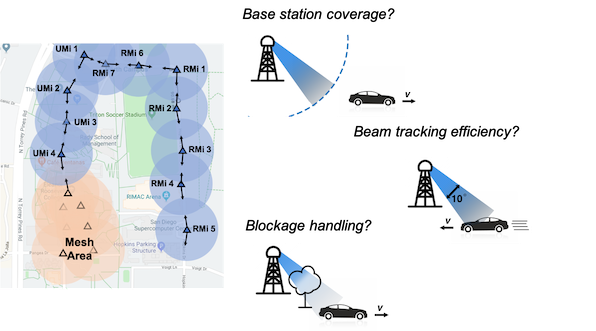Hybrid V2X Communications
Project Description
For smart transportation systems in the realm of 5G and IoT, V2X communication with wireless technologies, e.g., DSRC, Cellular V2X (C-V2X), or mmWave are used. The V2X communications can be bidirectional and can be between vehicle-to-infrastructure (V2I), vehicle-to-vehicle (V2V), vehicle-to-pedestrian (V2P), or vehicle-to-network (V2N) which connects the vehicles to the macro cell. In the context of vehicular edge computing, we consider V2I communication between the vehicles and small cell base stations. Each small cell can serve multiple vehicles which move with high speed and are at different distances from the small cell base station. As a result the wireless link quality can vary significantly with respect to space and time and an adaptive hybrid V-2X communication can help overcoming these dynamic variations.
Project 1: mmWave based V2X Communications
Millimeter-wave (mmWave) radios are a key wireless technology that can enable multi-gigabit data rates. UCSD is deploying a campus-scale reconfigurable mmWave network that is solar operated and capable of integrated access and backhaul, a wireless technique that allows for cellular base stations (BS) to communicate with one another via the same wireless transmissions that they utilize for communications with cellular users. By including a renewable energy source and removing the need for a wired link to connect each BS to the internet, these cellular BS can be quickly deployed without the costly need to build new infrastructure to support them. Additionally, the team is investigating applications of Artificial Intelligence to provide more optimal control of the mmWave network that further increases energy efficiency, network capacity, and the coverage achievable by a single BS.
Most prior work in mmWave V2X has relied solely on simulated or extrapolated results through time dilation; however, building a reconfigurable mmWave network, at campus scale, will provide unique insights that lead to new research problems or real-world validation of proposed solutions to currently known problems such as beam tracking and blockage recovery in high mobility. Multiple roadside base stations are being deployed on campus consisting of a reconfigurable commodity mmWave radio along with solar power. While many of the nodes have their own wired backhaul, the network is capable of testing a mesh configuration where mmWave nodes are deployed without a connection and utilize mmWave links to adjacent nodes to serve their users (Integrated Access and Backhaul). The deployed mmWave network will be accompanied by mmWave radios utilized by researchers acting as vehicles and/or pedestrians to allow real-world data collection and network testing.
Utilizing the deployed mmWave network, we will be able to determine: mmWave base station coverage in an urban campus environment, ability to track narrow mmWave beams at driving speeds, and the ability to detect and quickly recover from dynamic blockages that occur. Further, the data collected can be used in machine learning algorithms along with providing insights into the achievable QoS in a mmWave V2X network.

